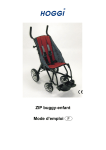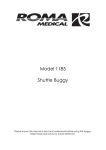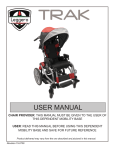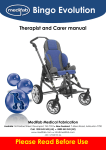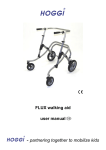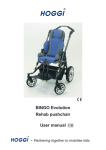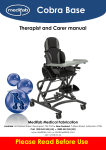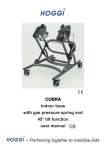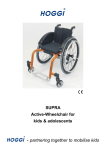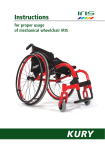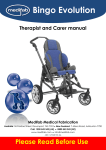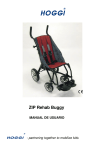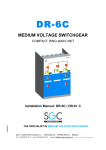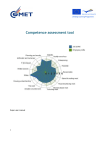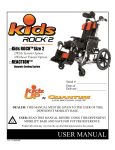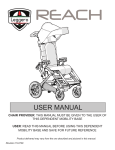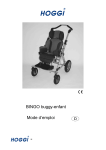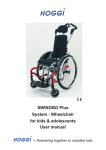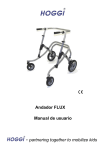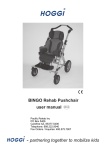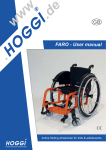Download ZIP Rehab Buggy user manual
Transcript
ZIP Rehab Buggy user manual GB/US - partnering together to mobilize kids User Manual for ZIP® Rehab-Buggy Contents Page 1 Common Information 1.1 Preface ___________________________________________________________________ 2 1.2 Application _________________________________________________________________ 2 1.3 Declaration of conformity______________________________________________________ 2 1.4 Terms of warranty ___________________________________________________________ 2 1.5 Servicing and repairs_________________________________________________________ 2 2 Safety Instructions ______________________________________________________________ 3 2.1 Meaning of symbols _________________________________________________________ 3 2.2 Common safety instructions ___________________________________________________ 3 3 Delivery and Preparing for Use ____________________________________________________ 6 4 Adjusting and Adaptation Possibilities _____________________________________________ 8 4.1 Wheel lock _________________________________________________________________ 8 4.2 Recline ___________________________________________________________________ 8 4.3 Lower leg length ____________________________________________________________ 8 4.4 Footrest angle adjustment ____________________________________________________ 10 4.5 Seat depth ________________________________________________________________ 10 4.6 Detaching wheels with quick release ___________________________________________ 10 4.7 Pneumatic tyres____________________________________________________________ 10 5 Accessories ___________________________________________________________________ 11 5.1 Swivel Lock _______________________________________________________________´11 5.2 Attendant brake ____________________________________________________________ 11 5.3 Tie down kit _______________________________________________________________ 12 5.4 Foldable back rest upholstery ________________________________________________ 12 5.5 Foldable seat upholstery _____________________________________________________ 12 5.6 Multipart contoured seat cushion ______________________________________________ 12 5.7 Lap Belt __________________________________________________________________ 13 5.8 Five-point Harness _________________________________________________________ 13 5.9 Ankle huger _______________________________________________________________ 15 5.10 Grap Rail with upholstery ____________________________________________________ 15 5.11 Therapy Tray ______________________________________________________________ 15 5.12 Winter Warmer ____________________________________________________________ 15 5.13 Rain Cape ________________________________________________________________ 16 5.14 Canopy with rain cover ______________________________________________________ 16 5.15 Buggy-Board ______________________________________________________________ 17 5.16 Sun shade ________________________________________________________________ 17 5.17 Nylon bag for transport ______________________________________________________ 17 6 Transportation _________________________________________________________________ 17 6.1 In the Trunk of a Car ________________________________________________________ 17 6.2 Using ZIP® Rehab Buggy for Bus Transport ________________________________________ 18 7 Maintenance __________________________________________________________________ 18 8 Technical Data _________________________________________________________________ 19 1 1 Common Information 1.1 Preface Thank you for selecting the ZIP® Rehab Buggy. We have designed this high-quality product to make your life safer and easier, and we have included this manual to help you use and care for it. Please read the following instructions to make sure you use this product as recommended. If you have any further questions or if you have any problems, please contact your healthcare provider. We hope that the ZIP® Rehab Buggy meets your expectations. The design, as described in these Instructions for use, are subject to technical alterations without notice. 1.2 Application Rehab pushchairs, paediatric postural positioning systems or strollers are appropriate for individuals requiring mobility assistance. Assistance may be required due to: • atypical muscle tone; • loss of limbs; • joint instability; • joint contractures; • joint defects; • general weakness. 1.3 Declaration of Conformity HOGGI® GmbH as manufacturer with sole responsibility declares that the ZIP® Rehab Buggy conforms to the requirements of the 93/42/EEC Guidelines. 1.4 Terms of Warranty Warranty applies only when the product is used according to the specified conditions and for the intended purposes, following all manufacturer’s recommendations. 1.5 Service and Repairs Service and repairs on the ZIP® Rehab Buggy should only be carried out by authorized HOGGI dealers. Should any problems arise, please contact the dealer who supplied your ZIP® Rehab Buggy. Authorized dealers only fit original HOGGI spare For repair and service, the following tools are required: Allen wrench, sizes 4 mm, 5 mm and 6 mm; wrench, sizes 10 mm, 13 mm, 19 mm. Your authorized HOGGI dealer: 2 2 2.1 Safety instructions Meaning of symbols Caution! Warning of possible danger of accident and injury. Warning of possible technical damage. Information! about use of product Information! for service-personnel Attention! Read manual before use! 2.2 Common safety instructions Read manual completely before use! Familiarize yourself with handling and functions of the product before use and practice the handling. You are responsible for the safety of your child. The safety of your child could be affected if you do not follow the instructions of this manual. Nevertheless not all possible circumstances and unpredictable situations can be covered by this manual. Reason, care and circumspection are not features of the product, they are required of persons who use the product. The person who is using the product and its accessories should understand all instructions and should explain them to every person using the product and its accessories. If instructions are not clear and further explanations become necessary or if you have further questions, please contact your HOGGI dealer. Strap your child at any time in the Rehab Buggy. HOGGI points out that any use beside the typical use can be dangerous. The Rehab Buggy is not suitable for jogging, running, skating or similar activities. Swivelling front wheels tend to wobble at higher speed which can cause a sudden stop and tip over of the Rehab Buggy. Use the pushchair only at regular walking speed. Under no circumstances leave the handle bar while pushing and never push the chair away. The Rehab Buggy should only be used on solid level ground. Use your Rehab Buggy as intended by the manufacturer. For instance, do not drive into obstacles (including steps, curbs) without braking. To clear obstacles such as steps and curbs, tilt the Rehab Buggy onto the rear wheels (pull it backwards to go up; to descend, slowly lower it forward). Do not go up or down stairs without the assistance of another person. If devices such as ramps or elevators are available, please use them. If they are not available then the Rehab Buggy should be carried over the obstacle by two persons. 3 Pay particular attention when on slopes and inclines to prevent - the child from falling out of the Rehab Buggy; - the Rehab Buggy from tipping over; - the Rehab Buggy from rolling away. If you have to park on a slope, face the Rehab Buggy uphill with the brakes engaged and ensure that the back rest is in the upright position. There is a risk that the Rehab Buggy might tip over backwards if the back rest is in the reclined position. Before leaving the Rehab Buggy and before getting into and out of it, always lock the wheel locks. Do not stand on the footplate when getting into or out of the Rehab Buggy. Only lift the Rehab Buggy by parts that are solidly attached: - front frame tube above the front wheels; - push handles. When your child reaches for objects in front, to the side or behind the Rehab Buggy, be sure that he/she does not lean out of the Rehab Buggy too far since the shift in the center of gravity might cause the pushchair to tilt or tip over. The handling of the Rehab Buggy is strongly influenced by tyre pressure. Correctly inflate tyres considerably improve its maneuverability. The air pressure should be at least 2 bar (200 kPa resp. 29 PSI). The ZIP® Rehab Buggy should be checked for correct function before every use. Please keep packaging material away from children. Plastic packaging presents the danger of suffocation. Never leave your child unattended in the Rehab Buggy even when they are strapped in and the brakes engaged. Before using the Rehab Buggy both folding guards must be firmly locked in place. Static stability is more than 15° inclination. Attaching heavy bags or other weight to the push handles can adversely affect stability. Trays must not be loaded with objects heavier than 5 kg. The Rehab Buggy is only intended to carry one child at a time. 4 The maximum load for the ZIP® Rehab Buggy is 50 kg. Accessories and add-ons reduce the maximum load capacity proportionately. Attention! We recommend that, wherever and whenever possible, users transfer to the seats installed in the motor vehicle and use the corresponding vehicle restraint systems, because this is the only way to ensure optimum protection of the passengers in case of an accident. Your ZIP® Rehab Buggy was successfully tested in accordance with ANSI/RESNA WC/19 and ISO 7176/19 (Crash Test). It is, however, possible to use your ZIP® Rehab Buggy as a seat in a motor vehicle if our “Tie down Kit” (article 3210-7300) as well as appropriate restraint systems are used. Whenever you change any settings on the ZIP® Rehab Buggy make sure that you firmly tighten any screws that have been loosened. 5 3 Delivery and Preparing for Use The original package contains the following components: • Rehab Buggy, folded; • instructions for use and special tools as required; • accessories as ordered. Carefully remove the transport safety items and packaging material. To unfold the Rehab Buggy please proceed as follows: • Lift the pushchair using the black handle grips on the push handles and unfold it until you can set it on its wheels. Caution! Never hold on to anything else than the described movable parts, especially the scissors mechanism! Crushing injury may occur! • Press the push handles backward until the folding guards engage. • Check both folding guards and engage them if necessary. 6 • Push down on the folding lever on the backrest until detent lug. • Fold the footrest forward. • Pull the release belt as shown towards the edge of the footrest in order to make lock pins move towards the inside. • Swing the footrest to the desired angle and let the lock pins snap in place. For interfolding the Rehab Buggy repeat the procedure in reversed order. 7 4 Adjusting and Adaptation Possibilities 4.1 Wheel lock To put the wheel lock on push the wheel lock lever downwards and roll the pushchair slightly back or forward, so that the lock pins can engage in the brake disc. Never use force! This could damage the quick releases and the wheels could fall off and cause injuries. The wheel lock should not be actuated while the push chair is moving! To disengage the wheel lock pull the wheel lock lever upwards with your toe. 4.2 Recline After slight opening of the star handles on both sides the backrest can be adjusted to desired angle. Tighten star handles afterwards. Whenever you change any settings on the ZIP® Rehab Buggy make sure that you firmly tighten any screws that have been loosened. 4.3 Lower leg length After loosening hexagon socket head cap screw on both clamping devices the footrest can be adjusted in height. Make sure that the footrest is on the same level on both sides before tightening the hexagon socket head cap screw. 8 In the case of dissimilar lower leg length it is essential to remove screw joint (A) before moving the clamping devices.. A ..and to move the clamping device past the screw joint. The screw joint must be affixed afterwards. If the lower leg length adjustment is blocked by screw joint (A) the clamping device can be dismounted and remounted the other way around. For that purpose the entire footrest must be drawn off from the footrest adapter. The right clamping device must be exchanged with the left clamping device. Whenever you change any settings on the ZIP® Rehab Buggy make sure that you firmly tighten any screws that have been loosened. The minimum lower leg length adjustment of 20 cm can only be reached with the depicted mounting alternative and is limited due to a detent lug. 9 The maximum lower leg length adjustment of 39 cm can only be reached with the depicted mounting of the clamping device. If the clamping device is flush with the tube end, maximum lower leg length adjustment is reached. 4.4 Footrest angle adjustment • Pull the release belt towards the edge of the footrest in order to move the lock pins towards the inside. • Swing the footrest to the desired angle and let the lock pins snap in place. • Since the clamping device can be turned around the snap in positions are available twice. 4.5 Seat depth After loosening and removing the screw joints of the seat cover and the seat rails the seat can be mounted in two different seat depths by any authorized dealer. ZIP® Rehab Buggy size 1: 30 cm or 35 cm Whenever you change any settings on the ZIP® Rehab Buggy make sure that you firmly tighten any screws that have been loosened. 4.6 Detaching wheels with quick release In order to achieve a most compact folding package the rear wheels of all models are detachable by quick release hubs. To detach press the quick release spring towards the middle of the wheel and pull the wheel from the axle. To attach the wheel push it onto the axle until the quick release engages automatically. Ensure that the wheel is securely held onto the axle by pulling the wheel without operating the quick release. 4.7 Pneumatic tyres (option) All wheels are equipped with pneumatic tyres. Maintain proper pressure at all times Notice the air pressure indicated on the tyre. 10 5 Accessories All accessories which are not installed by the manufacturer must be installed by trained technicians. The following notes on installation are for your information but should be performed by trained technicians. * All accessories indicated with ( ) has to be removed before folding the Rehab-Buggy. Straps on accessories are usually extra long to accommodate every option. Excess strap ends on accessories may be trapped by interfolding the Rehab Buggy. Shorten excess strap ends on accessories so that they can not be trapped. To prevent strap ends from fraying the cut ends can be melted together with a flame. (eg. cigarette lighter) 5.1 Swivel lock The swivel lock is mounted by the manufacturer or an authorized dealer. To lock the swivel lock turn the lock pin by 90° and let it engage in the designated hole in the castor fork. To open the swivel lock pull the lock pin, turn it by 90° so that it stays in the disengaged position. After loosening the clamping screw the track can be adjusted with engaged swivel lock. 5.2 Attendant brake The ZIP® Rehab Buggy can be fitted with an attendant brake. The brake mechanism can be operated with two independent brake lever. The attendant brake is designed to be a brake and not a wheel lock for parking. For parking the original wheel lock remains in function. Adjustments: The attendant brake set is pre adjusted. Nevertheless, if adjustments become necessary just after installation or after a period of use there are the following option: At the exit of each brake housing a cranked set screw leads the brake cable away from the tire of the rear wheel. After loosening the counter nut the pre tension of the individual (left or right) brake can be adjusted. Tighten the counter nut firmly again and ensure that the crank of the set screw shows towards the rear frame away from the tire. 11 5.3 tie down kit Your ZIP® Rehab Buggy has been tested successfully (Crashtest). Using our tie down kit (article 3210-7300) and the application of adequate restraint systems your ZIP® Rehab Buggy is approved for the application in vans for disabled. For transportation the tie down belt will be attached to the floor pan and the restraint system (lap belt, three-point belt) will be affixed to the child (also see chapter 8 Transport). 5.4 foldable back rest upholstery Your ZIP® Rehab Buggy can be equipped with an foldable backrest upholstery and a foldable seat upholstery respectively. Both cushions are compatible with a five-point harness In order to attach the backrest upholstery lay the cushion onto the nylon cover of the backrest and secure the backrest upholstery with the Velcro fasteners on the top and bottom edge of the nylon cover. 5.5 foldable seat upholstery The foldable seat upholstery will be attached to the nylon cover of the seat with Velcro fasteners, just like the backrest upholstery. * 5.6 multipart contoured seat cushion ( ) This cushion consists of a flexible pillowcase and various foams. There are three different cushions for the ischial tuberosity area available. Included in delivery are foam wedges which can be used to adjust not only adduction but also abduction within the cushion. 12 Attach the contoured seat cushion with the nylon seat cover with the Velcro fasteners. The seat cushion has to be removed before folding the rehab-buggy. It cannot be used in combination with a five-point harness. 5.7 lap belt On each end of the lap belt you can find pre mounted triglides which are passed by the belt only once. The length of the free belt ends determine the length of the complete lap belt. Pass the free belt ends through the designated slots in the lower part of the back base. Then thread the belt ends once again through the triglides. Open the lap belt by pushing the red key on the buckle. The lap belt can be adjusted by pulling the belt end next to the buckle. 5.8 Five-point harness Preparation/Installation: There are several holes in different heights on the back covering. Fix the buckle as shown using the black plastic washers and self securing nuts at the desired height on the back covering. 13 There are several holes on the seat covering in various depths. Fix the buckle at the end of the (middle)-belt in the desired position. Start the mounting below with the lens head screw M5x14, and fix it above with a washer and the selfsecuring M5 cap nut. The position should be closest to the body but not under the bottom. The back rest upholstery can be pushed over the belt ends and attached with Velcro fasteners. The seat cushion can be mounted to the seat with Velcro fasteners and the belt of the belt buckle can be run through the opening in the seat cushion. The ends of the five-point lap belt are mounted as described in 5.7 lap belt and the length is roughly initialized. To take the five point harness off proceed as follows: • Press the red key on the buckle. • Press the keys of the length adjusters and pull the strap out so that approx 5 cm (2 inches) of the strap end remains. • Create wide loops which allow to move the arms of your child out of the harness easily. • Lift your child out of the seat. To put the five point harness on proceed as follows: • Place your child into the seat. • Put the elbow of your child through one of the shoulder strap loops first and then the forearm and hand. • Proceed with the other arm the same way. • Put the buckle members one after each other into the buckle. • Tighten shoulder and lap straps by pulling the strap ends coming out of the length adjuster. 14 5.9 ankle hugger Ankle huggers allow a comfortable fixation of the foot joints. They are fixed to anchors on the foot plate. The heel should be placed against the heel plate of the footrest. The belts are opened/closed and adjusted with velcro straps. * 5.10 Grap rail with upholstery ( ) Push the Grab rail as depicted into the adapter at the end of the seat rail. While you do it keep squeezing the spring buttons. The grab rail is bent and therefore it can be inserted towards the child or away from it. Open the grab rail by pressing the release buttons and pulling the rail all the way out. The cover can be removed after opening the zipper. * 5.11 Therapy tray ( ) The therapy tray will be attached and removed just like the grab rail. After loosening the clamping lever height and angle of the tabletop are adjustable. Notice the maximum load capacity of the therapy tray Trays must not be loaded with objects heavier than 5 kg (11 lb). * 5.12 Winter warmer ( ) Zippers allow the upper part of the winter warmer to be opened or removed. Place the winter warmer in the stroller and tie with the straps. 15 For securing the winter warmer pull the straps to the outside and attach to the rear frame. Before folding the rehab-buggy the winter warmer has to be removed. * 5.13 Rain cape ( ) With the zip-fastener open pull the rain cape over the child’s head, then unfold the upper end over the backrest and the lower end around the footrest. 5.14 Canopy with rain cover Delivery and preparing for use: - If not done due to delivery in factory, your authorized dealer will mount the canopy adapters to the left and right side of the frame. - Insert the male pins of the canopy into the canopy adapter. - Adjustable ratchet joints are used to set the angle of the canopy. - Spread the canopy and wrap over the backrest of the seat. Canopy with Rain Cover: Take the rain cover out of the bag attached to the wrap, unfold the rain cover, pull it over the unfolded canopy and put it over the footrest assembly. For folding the rehab-buggy the canopy does not have to be removed. Fold the canopy as shown onto the seat. 16 Continue by interfolding the Rehab-Buggy as described in chapter 3. * 5.15 Buggy-Board ( ) For the transportation of a second child the ZIP® Rehab Buggy can be equipped with a detachable Buggy-Board. The adapters have to be mounted to the rear frame, above the rear wheels as shown in the picture. * 5.16 Sun shade ( ) For sun screening the ZIP® Rehab Buggy can be equipped with a sun shade. In order to attach the sun shade screw the adapter on the top end of one push Handle as depicted. The sun shade can be removed from the adapter due to a adapter system whereas the adapter remains on the push handle by interfolding the Rehab Buggy. 5.17 Nylon bag for transport The customized carriage bag for the ZIP® Rehab Buggy is made of permanent nylon and serves as a carriage bag and a mud guard. 6 Transportation 6.1 In the Trunk of a Car Due to its compact folding size the ZIP® Rehab Buggy can be stored in any trunk. Please make sure to secure the buggy against slipping. 17 6.2 Using ZIP® Rehab Buggy for Bus Transport Attention! We recommend that, wherever and whenever possible, users transfer to the seats installed in the motor vehicle and use the corresponding vehicle restraint systems because this is the only way to ensure optimum protection of the passengers in case of an accident. Your ZIP® Rehab Buggy was successfully tested in accordance with ANSI/RESNA WC/19 and ISO 7176/19 (Crash Test). It is, however, possible to use your ZIP® Rehab Buggy as a seat in a motor vehicle if our “Tie down Kit” (article 3210-7300) as well as appropriate restraint systems are used. 7 Maintanance Your ZIP® Rehab Buggy is CE approved. Herewith the manufacturer guarantees that this medical product as a whole conforms to the requirements of 93/42/EEC Guideline. The ZIP® Rehab Buggy should be checked for correct function before every use. The items listed in the following table must be checked by the user at the indicated intervals. Failure to carry out these simple checks may lead to problems arising that could invalidate the warranty. Check daily Function test of the brake/wheel lock X weekly Check of screw connections X Air pressure (indicated on the side wall of the tyre) X monthly Visual inspection of wearing parts such as wheels and bearings X Contamination on bearings X Should any defects become obvious, please contact your authorized HOGGI dealer to eliminate them. ® We also recommend that you have your ZIP Rehab Buggy serviced by your authorized dealer every twelve months. Instructions for Cleaning and Maintenance - Clean all frame components and plastic parts using mild detergents only. - Padding parts can be washed at 40 °C. If washed in a washing machine, put them in a linen bag or a pillow case. - In most cases, wiping with a damp cloth is sufficient. - Do not use your ZIP® Rehab Buggy in salt water. - Keep sand or other particles from damaging the wheel bearings. 18 8 Technical data Dimensions cm (inches) and weights kg size 1 Seat depth 30 cm / 35 cm (11.8 / 13.8) Seat width 35 cm (13.8) Backrest height „standard“ 60 cm (23.6) Backrest height „long“ 66 cm (25.6) Lower leg length 20 - 39 cm (7.9 - 15.3) Permanent Tilt in space 18° Recline 90°-100° Foot plate angle -10°/0°/+10° Height push handle / overall height 112 cm (44.1) Overall width 59 cm (23.2) Wheel diameter front / rear 20 cm / 30 cm (7.9 - 11.8) Folding size (L x W x H) 78 x 36 x 39 (30.7 x 14.2 x 15.3) Weight 12,5 kg ( Load capacity 50 kg Turning radius 126 cm (49.6) Information! Accessories and add-ons reduce the remaining load capacity for the passenger proportionaly. 19 Hersteller/Manufacturer: © HOGGI GmbH 1910-0013-GB_02-2008 Hoggi GmbH Taunusstrasse 17 56235 Ransbach-Baumbach GERMANY Fon: (+49) 26 23 / 92 499-0 · Fax: (+49) 26 23 / 92 499-99 e-mail: [email protected] · Internet: http://www.hoggi.de





















